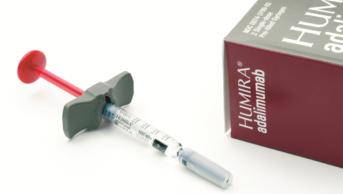
Shutterstock.com
Lithium is the most well-known treatment for bipolar disorder and, with proper monitoring, has been highly effective for more than 50 years[1]
.
Lithium carbonate has a relatively narrow therapeutic index so, to keep lithium levels within safe limits (0.4–0.8 mmol/L), regular plasma level monitoring is required. This is usually recommended to be every three months, although National Institute for Health and Care Excellence bipolar guidelines[2]
increased this to six-monthly, albeit without any qualification and despite concerns that this is too infrequent. For instance, it has been shown that any plasma level above 1mmol/L causes an acute decline in estimated glomerular filtration rate detectable up to a year afterwards[3]
.
This is why there is — for good reason — some concern over switching between lithium products, particularly those which are sustained release. Indeed, the Medicines and Healthcare products Regulatory Agency (MHRA) suggests that it needs to be considered as if the new product was being started as a new treatment.
Interruptions in lithium therapy have been strongly linked with relapse, particularly to manic phases[4]
. Relapse after a sudden discontinuation can also be high (median 50% risk of relapse within four months, 100% over 3.5 years) than with slower (15–30 days) withdrawal with a significant excess over the first six months, which supply problems could lead to unless managed properly.
Even controlled lithium discontinuation can lead to a high relapse in people who have had a good response[5]
, as can decreasing lithium levels, for instance, as in switching products in a non-cross-tapered way[6]
.
This is why the announcement that Priadel, the most prescribed brand of lithium in the UK, is being discontinued from April 2021 has caused so much concern among patients and healthcare providers. However, we believe that it is possible to manage this change successfully and without harm to patients with bipolar disorder, as there is a ready alternative that can be supplied, albeit at significant additional cost.
Lithium carbonate is available in the UK as Priadel (400mg; Essential Pharma), Camcolit (400mg; Essential Pharma), Lithium Carbonate Essential Pharma (250 mg f/c, previously called Camcolit and still with Camcolit stamped on them; Essential Pharma) and Liskonum (450mg tablets; Teofarma).
Priadel is the most prescribed UK brand of lithium, with around 757,323 items of both strengths prescribed in the 12 months between June 2019 and May 2020 in England, with most prescribed in primary care.
Switching between modified-release products can destabilise patients. A classic example is the myriad of methylphenidate modified-release products. The British National Formulary carries a warning that “different versions of modified-release preparations may not have the same clinical effect … [so] prescribers should specify the brand to be dispensed”. A comparison in Canada showed switching from Concerta to an approved bioequivalent generic methylphenidate had a failure rate over ten times the background rate[7]
and, in another, 87% destabilising after a switch[8]
.
This is not, we believe, the case with lithium carbonate. Norgine (who used to manufacture Camcolit) and Delandale (who used to manufacture Priadel) have disputed which had the superior sustained release, but careful analysis of their presented data comparing the 400mg tablets showed the differences to be insignificant. Both 400mg tablet brands are thus labelled ‘sustained release’, but, misleadingly, the 250mg Camcolit isn’t, despite being manufactured identically to the 400mg Camcolit.
Therefore, with clear guidance on the process of switching from Priadel, a positive and successful transition for patients with bipolar disorder is possible.
Response to current problem
The Department of Health and Social Care supply disruption alert for lithium carbonate (Priadel) (SDA/2020/012 issued 21 August 2020) outlines the issue and makes sensible general recommendations on how to proceed; mental health trust Choice and Medication website portals also have a specific patient and carer leaflet on the issue.
Pharmacists will need to work closely with local clinical commissioning groups and health boards to outline the strategy used to make the switch to the Camcolit brand, and using prescribing software to identify and communicate with lithium patients will be essential.
Specialist mental health pharmacy teams will have to issue detailed guidance, detailing pragmatic steps to facilitate a safe and effective swap. Because of the significant number of patients prescribed lithium, it is essential that the substitution is done in the safest possible way, while at the same time not overwhelming services.
This brand switch may lead to an increase in mental health referrals to secondary care, which might be stretched in the coming months as higher COVID-19 related mental health referrals are expected.
Hence, the possibility to undertake the switch without a lithium level seven days before and after could be considered for stable, low-risk lithium patients who have had a lithium level within range in the past three months.
This will not be possible for patients who are higher risk, and for whom strict lithium monitoring will be required. Higher-risk lithium patients include:
- Elderly (>65 years of age);
- Concomitant interacting drugs (non-steroidal anti-inflammatory drugs, angiotensin-converting enzyme inhibitors, angiotensin receptor blockers, diuretics);
- Established chronic kidney disease;
- Evidence of impaired thyroid function;
- Raised calcium levels;
- Poor symptom control;
- Poor adherence;
- Lithium serum level >0.8mmol/L.
The LiSERS (Lithium Side Effect Rating Scale)[9]
should be used to monitor the transition, and lithium levels should be arranged no later than three months after the switch.
It is likely that some people will find the change unsettling; however, most patients can be switched in primary care, with secondary care services providing guidance, support and training as required.
Switching lithium carbonate tablet brands needs to be done carefully, but it should be possible to make the switch without incident if undertaken properly, with a full discussion with the patient and any carers to explain the need for the change and to make a joint decision about the options.
Patients should be advised to take doses exactly as they did before at the closest dose possible and without a break. If the dose changes, then they should be advised to have a blood test before they switch, then another one a few weeks after switching. More advice and suggested conversion doses are available below (Box 1; Table 1).
Box 1: Practical advice for switching from Priadel to Camcolit, Essential Pharma lithium carbonate or Liskonum
- Take the doses exactly as you did before at the closest dose possible (see Table 1);
- If you are taking Priadel tablets twice a day it would be a good time to switch to once a day (at bedtime), which has less risk to your kidneys;
- The switch should be made without a break — start Camcolit, Essential Pharma lithium carbonate or Liskonum at your full dose the day after your last dose of Priadel;
- Make sure your prescription includes the trade name for lithium and does not just say “lithium carbonate”;
- If your dose isn’t exactly the same as it was before, have a blood test to measure your lithium level before you switch, then another one a few weeks after switching;
- But, whatever you do, do not run out of tablets or stop taking lithium — that could lead to your symptoms quickly coming back, particularly going high (manic);
- Make sure your blood level is checked at the same time of day (e.g.12 hours after a night-time dose);
- Be aware of any changes in how you feel or if you’re getting more side effects or less effect. Having said that, it’s unlikely you’ll notice the change;
- Contact your prescriber, pharmacist or mental health team if you have any problems or concerns about the change.
| Table 1. Priadel conversion doses to Camcolit modified-release tablets and lithium carbonate film-coated tablets | |
|---|---|
| Source: authors’ calculations | |
| Current prescription (Priadel) | Suggested alternative (Camcolit 400mg modified-release (MR) tablets and lithium carbonate 250mg film-coated (f/c) tablets |
| 200mg | Lithium carbonate f/c tablet 250mg |
| 300mg | Lithium carbonate f/c tablet 250mg; OR: Camcolit MR tablet 400mg |
| 400mg | Camcolit MR tablet 400mg |
| 500mg | Lithium carbonate f/c tablet 500mg (2 x 250mg f/c tablets) |
| 600mg | Lithium carbonate f/c tablet 500mg (2 x 250mg f/c tablets); OR: Camcolit MR tablet 400mg PLUS lithium carbonate 250mg f/c (total 650mg) |
| 700mg | Camcolit MR tablet 400mg PLUS lithium carbonate 250mg f/c tablets (total 650mg); OR: lithium carbonate f/c tablets 750mg (3 x 250mg f/c tablets) |
| 800mg | Camcolit MR 800mg tablets (2 x 400mg) |
| 900mg | Camcolit MR 400mg PLUS lithium carbonate 500mg f/c (2 x 250mg f/c tablets) (total 900mg) |
| 1,000mg | Lithium carbonate 1,000mg f/c tablets (4 x 250mg f/c tablets); OR: Camcolit MR 800mg tablets (2 x 400mg) PLUS lithium carbonate 250mg f/c (total 950mg) |
More advice and suggested conversion doses can be found on the online version of this article:[tiny url link to article]
All patients should be told to be aware of any changes in how they feel and contact their prescriber, pharmacist or mental health team if they are getting more side effects or less effect.
It is also vital that prescribers do not issue higher-than-usual quantities of Priadel for their patients. The company has guaranteed that there are enough supplies to last until April 2021 and overprescribing may compromise this and cause a dangerous medication shortage.
There is also the issue of price. If the Drug Tariff price for Priadel 400mg is £4.02 and Camcolit 400mg is £48, there may be concern locally and may prompt some to consider discontinuing treatment, with the health risks previously mentioned.
Through the College of Mental Health Pharmacy, mental health pharmacists are in constant conversation to ensure that the safest practice and most appropriate proceedings are employed across the UK to manage this change. Although the transition of lithium brands will not be problematic for the majority of patients, it will be a significant undertaking for the NHS.
Stephen Bazire, honorary professor, School of Pharmacy, University of East Anglia; director, Mistura Enterprise Ltd
Nana Tomova, lead pharmacist mental health, Brighton & Hove and East Sussex Community Teams, Sussex Partnership Foundation Trust
- On 30 September 2020, this article was updated to clarify that Camcolit and Priadel are no longer made by pharmaceutical companies Norgine and Delandale, respectively. These drugs are both currently manufactured by Essential Pharma.
References
[1] BALANCE investigators and collaborators. Lancet 2010;375:385–395. doi: 10.1016/S0140-6736(09)61828-6
[2] National Institute for Health and Care Excellence. Bipolar disorder: assessment and management. 2020. Available at: https://www.nice.org.uk/guidance/cg185 (accessed September 2020)
[3] Kirkham E, Skinner J, Anderson T et al. BMJ Open 2014;(4):e006020. doi: 10.1136/bmjopen-2014-006020
[4] Baldessarini RJ, Tondo L, Floris G et al. Am J Psychiatry 1997;154(4):551–553. doi: 10.1176/ajp.154.4.551
[5] Yazici O, Kora K, Polat A et al. J Affect Disord 2004;80(2–3):269–271. doi: 10.1016/S0165-0327(03)00133-2
[6] Perlis RH, Sachs GS, Lafer B et al. Am J Psychiatry 2002;159(7):1155–1159. doi: 10.1176/appi.ajp.159.7.1155
[7] Park-Wyllie L, van Stralen J, Castillon G et al . Clin Ther 2017;39(10):2006–2023. doi: 10.1016/j.clinthera.2017.08.01
[8] Van Stralen JPM. Paediatr Child Heal 2013;18(2):70–73. doi: 10.1093/pch/18.2.70
[9] Haddad P, Wieck A, Yarrow M et al. Eur Neuropsychopharmacol 1999;9(S5):231–232. doi: 10.1016/S0924-977X(99)80180-1


